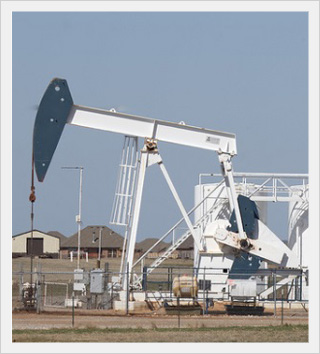 Every industry faces its own unique challenges when it comes to regulatory compliance, based on the types of activities, products, and materials used on site. Those industries using more heavily regulated types of materials or equipment face more strenuous reporting requirements.
Every industry faces its own unique challenges when it comes to regulatory compliance, based on the types of activities, products, and materials used on site. Those industries using more heavily regulated types of materials or equipment face more strenuous reporting requirements.
The Oil & Gas and Chemical industries are definitely among those industries that face
a higher degree of regulatory complexity based on the type of equipment used on site for a number of processes: tanks of all types create a significant regulatory burden.
Tanks are particularly difficult to manage from a compliance standpoint: the emission calculations for standing and working losses can be difficult enough, but there are also a large number of factors that need to be accounted for, ranging from the type of roof on the tank all the way down to what color the tank is. Tank owners and operators even need to know what the temperature was on any given period, making recordkeeping and data collection a top concern.
For these reasons, EH&S Software for tanks, also known simply as Tanks Software, has become an essential tool for anyone who owns, operates, or manages a facility that uses any type and number of tanks - even if it’s just a single tank.
So what makes Tanks Emissions Software a must-have tool in your toolbox instead of a nice perk? If you’re considering Tanks Software or are simply apprehensive about your emissions reporting this year, consider the following:
EPA TANKS Falling Behind
The EPA developed an online reporting platform for tank operators called TANKS which was meant to be able to closely estimate air emissions from different types of basic tanks. Unfortunately, as the industry’s knowledge of environmental management advanced, it was found that TANKS is unable to calculate emissions from certain common scenarios - including nearly any calculation requiring temperature data.
Currently, the Texas Commission on Environmental Quality (TCEQ) does not accept many estimates from TANKS and requires reporters to use a proven alternate software or to do the emission calculations by hand. Even the EPA has included a disclaimer that TANKS should not be used for precise estimates for some operating scenarios.
With TANKS losing ground as a top reporting tool, tank operators - particularly those in the state of Texas - should be seeking out a more viable, permanent option.
Manual Calculations for Tanks Not Efficient or Effective
There are some emission source calculations you can do manually, but tanks are not among that group. A single tank can require many different variables, meaning that estimating emissions from one tank containing one type of material over the reporting period can take a great deal of time and cross referencing against industry literature and emission factors.
At a recent conference, an Environmental Manager utilizing spreadsheets mentioned his exasperation with trying to do generate the Emission Inventories based on multiple operating scenarios — Alternate Operating Scenarios & Maintenance Startup Shutdown. The manager expressed a common sentiment: “These Spreadsheets are Killing Me!”
You’ve probably thought this yourself on numerous occasions. And the alternative isn’t a lot better if you are instead paying a Consultant to generate the emissions calculations. If you’re paying someone to spend hours and hours each quarter to do emission calculations by hand for each of your tanks and research emission factors, temperature data, and chemical compositions you’re throwing away your money.
With Tanks Emissions Software, you should be able to determine emissions from an entire battery of tanks for a desired reporting period within a few minutes, because the program will reference all emission factors, chemical data, temperature data, and tank type-related factors automatically within seconds. You should be able to automatically take credits to the Emission Inventory for all of the control technologies you utilize onsite.
Investing in Software is a Visible Act of EH&S Commitment
Most Oil & Gas businesses are especially vulnerable to negative brand image and damage to reputation. An incident in the Oil & Gas sector typically has a larger environmental and health impact and gets more media attention. Stock values can go down for everyone in the industry - even if they weren’t attached to the incident.
There are many ways to demonstrate to your regulators and to the buying public that your business is committed to environmental preservation and protecting human health, whether that’s joining an industry advocacy group, spearheading a EH&S initiative, or implementing EH&S software that shows your regulators how much EH&S matters to you.
Rapidly-Evolving Oil & Gas Regulations Require Agile Solutions
The Oil & Gas industry faces compliance with regulations that change faster, are challenged more often, and are stricter than almost any other industry in the world.
Keeping up with these changes isn’t a task that a single EH&S manager, or even a team, can keep up with while being responsible for reporting and continuous improvement. One of the biggest advantages of Tanks Software is that it can handle the regulatory research for you, letting you handle the important tasks while it automatically updates its emission factors and standardized calculations.
All of these reasons for finding and implementing Tanks Emissions Software also point to the specific features and attributes that you should demand in any Tanks Software you are considering. When you begin your own search for the right Tanks Software look for the following:
Expert Implementation
Tank emissions are complicated enough already, so any solution you implement to speed up that process shouldn’t add to your burden. Look for a software provider that promises internal implementation, one that does the work for you, and one that never contracts out your implementation to a third-party that doesn’t know anything about tanks or your business.
Tanks software implementation shouldn’t be a year-long process. Depending on the complexity of your operations, your provider should be able to have your software up and running and your team fully trained in just weeks. Implementation should also include populating a database of your materials, emission factors, and tank-type variables so that all you have to do is generate reports.
Bottom line: Tanks Emissions Software implementation should be focused on letting you do your core tasks as quickly as possible instead of creating more work for you to worry about.
Automated Data Collection
Automated Data Collection is probably the most important of all Tanks Software features, so make sure any solution you choose offers this functionality. Robust Tanks Software should be able to directly upload data from your material vendors to track exactly what chemicals are stored, mixed, and processed through any of your tanks without you having to manually chase after data and enter it into the software yourself.
For example, ERA Tanks Software automatically collects chemical component data through a secure online vendor portal so that your tank emission calculations are more accurate and use the best available chemical data without adding to your workload.
For tanks, it’s also essential that your Tanks Software is able to automatically collect temperature data from trusted sources so that any calculations that are affected by temperature variables (i.e. hot and heated tanks) are accurate and take as little time as possible. Since temperature data is available online and provided by government sources, your Tanks Software should be able to use your physical location and cross reference that information to instantly get approved weather data.
Regulatory Updates Built In
Because the Oil & Gas industry’s regulations are updated so often, a Tanks Software that offers a long-term solution should also come bundled with life-long regulatory support and updates. Any changes to calculations, emission factors, or regulations should be incorporated into your software on a regular basis.
The very best Tank Emissions Software handles all of the regulatory research and updates for you. Your EH&S team doesn’t need to do any programming or customization when a regulatory change is passed down.
It’s for this reason that ERA employs a full-time team of regulatory researchers whose sole job is to ensure that any regulatory changes are incorporated into the Tanks Software and then notifying you of any important changes. That way your team has all the latest information but they don’t have to use up their time or your resources to maintain regulatory compliance.
Covers a Broad Range of Tanks
Each of the different tank types have their own calculations and variables to account for. Look for a Tanks Software that doesn’t just cover the basic fixed-roof tank and one that gives you more than just a basic estimate by ignoring the more complex variables. There’s no point implementing a Tanks Software that only covers half of the calculations you need to get done.
As with any type of resource management or EH&S software, look for something robust and comprehensive. And if you only need a Tanks Software that can handle a basic tank type right now, make sure your software solution of choice allows you to handle other types of tank calculations in the future, if your business grows to need other tank types. That can mean finding a software that offers a broader range of calculations, customizable reports, or modules you can add on later.
Gives Your Regulators What they Need
Any Tanks Software you choose should be able to generate outputs and reports in a format that your regulators can use to easily understand your operations and compliance. If you’re planning on using Tanks Software to improve the ease and speed of your compliance, ask the provider what format the outputs are available in and if they’re compatible with regulatory e-reporting tools.
Most Importantly, Gives You What You Want
Tanks Software, like any Oil & Gas EH&S Software, is a powerful tool that can be used for more than just regulatory compliance. It can be used to perform benchmarking, continuous improvement, and voluntary internal/external reporting. All of the above programs rely on having reliable data about your emissions at any given moment. For example, you could benchmark your tank emissions on a weekly or monthly basis in just minutes in order to benchmark your environmental impact or chart trends in output. Some businesses might choose then to include this tracking in a quarterly shareholder’s report or annual public sustainability report.
Because there’s so much that Tanks Software can do for you, bring your list of EH&S goals with you when assessing Tanks software and see how many items that provider can help you check off your list. Does the Tanks software provide executive dashboards that give you a real-time overview of your tank emissions? Does it provide automated warnings if you reach certain emission levels? Is it capable of reporting during Alternate Operating Scenarios and MSS events? Will the software incorporate all of your site’s Control Technologies to reduce the emissions calculated? Or will you have to capture the reduction and manually complete the calculation?
Most EH&S Managers and executives want more than just an emissions calculator - they want a full solution that gives them insight into their operations and offers better control of the flow of big data that each emission source generates. Custom reports, dashboards, real-time data collection, and compliance alerts should be considered standard features for Tanks Software rather than special features.
Your options for Oil & Gas software are numerous and range from the very comprehensive to the bare-bones emission calculator. Keep all of the above points in mind when making your decision.
Ask an ERA Expert:
Do you have any questions or concerns about the topic covered in this article? Want more insight? Now is your chance to ask one of ERA’s Environmental Specialists. Please leave your question or comment below and we’ll make sure one of our expert scientists responds.
Photo credit: Katsrcool
This Blog Was Co-Authored By:


Tags:
EHS Software
June 18, 2014
Comments